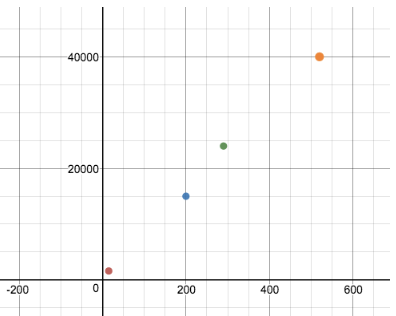Distances and Velocities of Galaxies Galaxy Virgo Ursa Minor Corona Borealis Bootes Distance 15 200 290 520 Velocity 1600 15,000 24,000 40,000 Data from Acker, A., and C. Jaschek, Astronomical Methods and Calculations, John Wiley and Sons. Karttunen, H. (editor), Fundamental Astronomy, Springer-Verlag
Distances and Velocities of Galaxies Galaxy Virgo Ursa Minor Corona Borealis Bootes Distance 15 200 290 520 Velocity 1600 15,000 24,000 40,000 Data from Acker, A., and C. Jaschek, Astronomical Methods and Calculations, John Wiley and Sons. Karttunen, H. (editor), Fundamental Astronomy, Springer-Verlag
Algebra and Trigonometry (6th Edition)
6th Edition
ISBN:9780134463216
Author:Robert F. Blitzer
Publisher:Robert F. Blitzer
ChapterP: Prerequisites: Fundamental Concepts Of Algebra
Section: Chapter Questions
Problem 1MCCP: In Exercises 1-25, simplify the given expression or perform the indicated operation (and simplify,...
Related questions
Question
The table lists the distances (in megaparsecs; 1
megaparsec = 3.085 × 10^24cm, and 1
megaparsec = 3.26 million light-years) and
velocities (in kilometers per second) of four galaxies moving rapidly away from Earth.
(a) Does there appear to be a relationship or trend for the data?
(b) Find a linear equation in the form y =max that models these data using the points (520,40000) and (0,0).
(c)The galaxy Hydra has a velocity of 60000 km
per second. How far away to the nearest megaparsec, is the galaxy according to the model in part (b)?
(d) The value of m is the Hubble Constant. The Hubble Constant can be used to estimate the age of the universe A (in years) using the
formula A = 9.5 x 10^11/m. Approximate A
using the value of m. Round to the nearest hundredth of a billion years.
(e) Astronomers currently place the value of the Hubble Constant between 50 and 100. What is the range for the age of universe A?

Transcribed Image Text:Distances and Velocities of Galaxies
Galaxy
Virgo
Ursa Minor
Corona Borealis
Bootes
Distance Velocity
15
1600
200
290
520
15,000
24,000
40,000
Data from Acker, A., and C. Jaschek, Astronomical
Methods and Calculations, John Wiley and Sons.
Karttunen, H. (editor), Fundamental Astronomy,
Springer-Verlag.
Expert Solution
Step 1: Given
The table lists the distances (in megaparsecs; 1 megaparsec = 3.085 × 1024cm, and 1 megaparsec = 3.26 million light-years) and velocities (in kilometers per second) of four galaxies moving rapidly away from Earth. We have to answer the following...
Solution (a): Plot the data using distances for the x-values and velocities for the y-values. Then we find

Therefore, The relationship appears to be linear.
Trending now
This is a popular solution!
Step by step
Solved in 3 steps with 2 images

Recommended textbooks for you

Algebra and Trigonometry (6th Edition)
Algebra
ISBN:
9780134463216
Author:
Robert F. Blitzer
Publisher:
PEARSON

Contemporary Abstract Algebra
Algebra
ISBN:
9781305657960
Author:
Joseph Gallian
Publisher:
Cengage Learning

Linear Algebra: A Modern Introduction
Algebra
ISBN:
9781285463247
Author:
David Poole
Publisher:
Cengage Learning

Algebra and Trigonometry (6th Edition)
Algebra
ISBN:
9780134463216
Author:
Robert F. Blitzer
Publisher:
PEARSON

Contemporary Abstract Algebra
Algebra
ISBN:
9781305657960
Author:
Joseph Gallian
Publisher:
Cengage Learning

Linear Algebra: A Modern Introduction
Algebra
ISBN:
9781285463247
Author:
David Poole
Publisher:
Cengage Learning

Algebra And Trigonometry (11th Edition)
Algebra
ISBN:
9780135163078
Author:
Michael Sullivan
Publisher:
PEARSON

Introduction to Linear Algebra, Fifth Edition
Algebra
ISBN:
9780980232776
Author:
Gilbert Strang
Publisher:
Wellesley-Cambridge Press

College Algebra (Collegiate Math)
Algebra
ISBN:
9780077836344
Author:
Julie Miller, Donna Gerken
Publisher:
McGraw-Hill Education